WW2 Soviet submersibles
 Soviet Navy – 238 submersibles 1928-45
Soviet Navy – 238 submersibles 1928-45
Boats surviving the civil war
long before the civil war, with the appearance of the first submarines at the occasion of the 1878 war, to negate the advantage of the massive Ottoman Turk navy, and in 1905, as a way to counterbalance the Japanese Imperial Navy. The delfin, Kasatka, Son, Forel, Osetr single units or limited classes were of the 1905 era, and the Pochtovy, Minoga, Akula, Karp class, Kaiman class, Morzh class, Narval class and the revolutionary Krab were all related to WWI. Modern Western designs were considered when licence-building in wartime the ‘Amerikansky Golland’ (Holland 602GF/602L type).
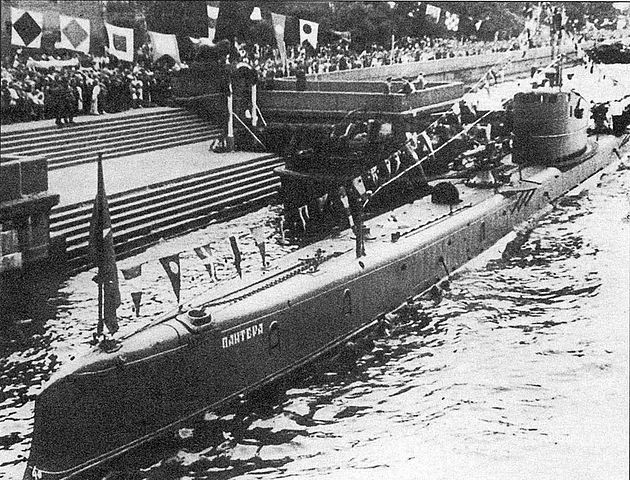
The Pantera in 1917. She almost look modern as the drop-collars initially planned were never fitted.
The very last properly Russian type was the Bars class (“Bear”), a 650 tons semi-oceanic type from the Baltic Yard, St Petersburg, and Noblessner Yard, Reval (now Tallinn), both planned for the baltic, black sea, and later “Siberian flotilla” and delivered between 1915 and 1917, but of course completion was disrupted by the Russian revolution for some. Of the 25 started only a handful survived the revolution and civil was and were still in service in 1930: Leopard, Pantera, Rys, Tur, Volk, Yaguar, Zmeya and Ezhr.
Two were lost in 1931, two in 1935, and the remainder were BU in 1936. The Bars design drew from previous designs from Ivan Bubnov, which already signed the Morzh class. They were crude, single hulled and lacked internal bulkheads. But they were a kind of upgraded and enlarged Morzh, with more powerful engines, better torpedo armament and larger guns. Diesels were of various origins and not satisfactory as thos intended were almost never delivered. Armament for the same reasos diverged greatly between boats, 63 mm, 37 mm, 63 mm and 75 mm. Torpedoes were of the old 457 mm caliber, but only four in conventional hull tubes in the bow, while the remainder 8 were surface-fired in drop-collars.
From these humble beginnings, the Soviet Navy, started late in the game but settling, like in other matters, on mass production rather than overall quality or innovation, and created the largest submarine force in the world, with 285 submarines, the immense majority of which were already in service when the war broke out. There was a vacancy of ten years on which to draw better, modern designs.
Rebirth in 1926
Submarine development of the Soviet Navy before WW2 started again in 1924 when early strategists of the Soviet Admiralty envisioned a form of naval defense close to the French theories of the young school, comprising few heavy units but many torpedo boats, minelayers, submersibles and coast guards. A green water navy that was defensive in essence, but designed to inflict maximal damage. The glory and power of the Imperial fleet prior ro 1905 was just a distant memory.
Surprisingly enough and despite of this, the Soviet submarine fleet in 1941 was the largest in the world, ahead of Germany and Italy, and Western democracies. It was classified in three categories: oceanic, coastal (coastal) and light (coastal). In addition, there were a number of former personnel on duty, the US-based class 4 (1916-23) and the Bezbozhnik, a former British class L submarine, sunk by “red” destroyers at Kronstadt, then captured, refloated, repaired and returned to service in 1931.
The oldest cruisers submarines were those of series I, comprising 6 boats (1928-29), followed by series II (6), series XI (6), series XIII and XIII bis (7 and 6). The latter, assimilated into a single large “L” class, of minelaying boats were completed shortly before, during or after the invasion. The Series IV (1934) was an unfortunate experimentation of submarine squadrons comprising only 3 units designed for the pacific fleet, not unlike the Dutch East Indies models. The XI series, of a standard oceanic type was produced around 38 boats, and the XIV series, 12 boats. These were the last of these major classes completed during the war.
Development of Soviet submarines
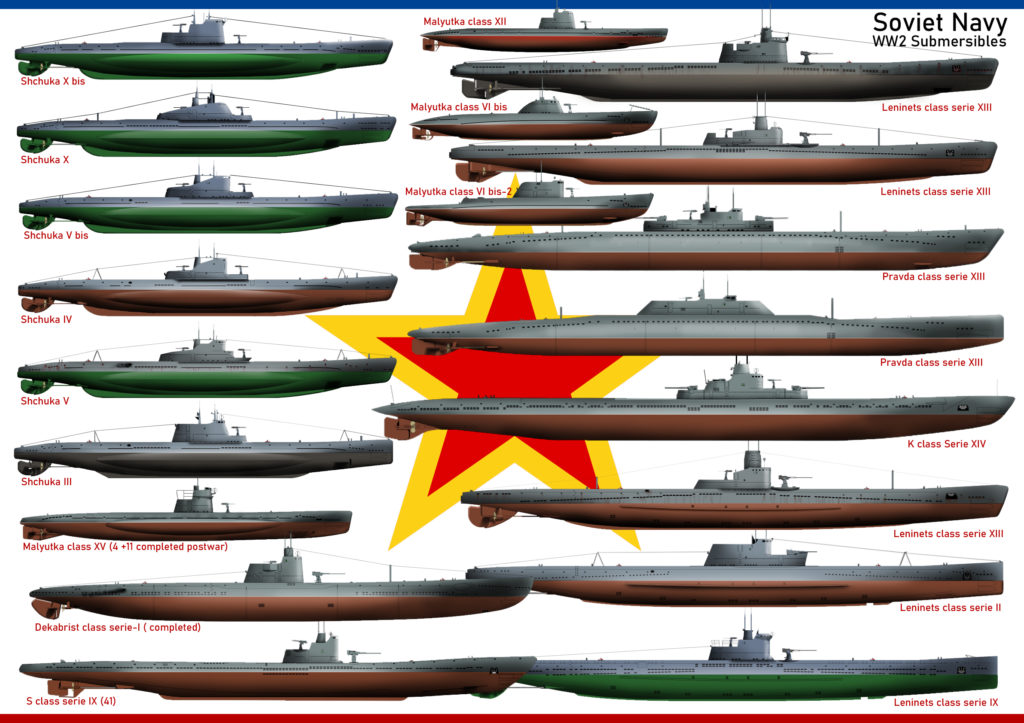
Tailored poster about WW2 Soviet submarines, with all series and sub-types, to have a better idea of their respective size.
Nomenclature
There was a letter associated to the major class, and series detailing each iteration. These letters were generic classes each filling a role:
-D class (Dekabrist) were “large positional submarine” (long range ambush types): Serie I
-L class (Leninets) were Mine layers (26 boats, series II, XI, XIII, XIII-bis or 1938 sub-type)
S class (Shchuka) were coastal boats called “Medium-sized patrol submarines” (88, series III, V, V-bis, V-bis-2, X, X-1938)
P-class (Pravda) were long range cruisers “oceanic types”, the three boats of the serie IV
M class (Malyutka) were standard small coastal patrol submarines (110 boats, series VI, VI-bis, XII, XV)
S-class (Stalinets) were German types oceanic “medium” types (41 boats, Series IX,IX-bis)
K class (?) were Cruiser submarines with combined arms (12 planned, 6 completed, series XIV)
Added to this there were a few captured boats integrated in a “TS” class, the former submarines of the Royal Romanian Navy, Rechinul (TS-1), Marsuinul (TS-2) and Delfinul (TS-3), of German construction and design.
Performances
The earliest class was called as ShCh, Shchuka or SC-class, as deriving from a prototype called “Schuka” (Russian for ‘pike’). This was the very first originally Soviet submarine design. The first boats of what will be called in Soviet nomenclature the series III were developed and built in the late 1920s. These were patrol boats able to stay in operations for 20 days at sea. The following V series had a larger endurance, an enhanced conning tower and a better gun. Although the first series III could only reach 11 knots in tests, the V series hopefuly solved this problem and were indeed much faster. The next X series again improved the speed factor, but also endurance, able to keep at sea for almost a month, whereas the the X-bis series were even faster.
The Shchuka class had two shaft diesel electric units rated for 1,020 kW (1,370 hp) from the diesel alone, and 600 kW (800 hp) in electric mode. Surface speed was mediocre at 12.5 knots (23.2 km/h; 14.4 mph) and submerged speed even worse at 6.3 kn (11.7 km/h; 7.2 mph). These were not sub-standard figures for the time however. If such surface speed prevented the submarines to be used to chase warships, they still can manage merchant traffic. They were best deployed however in “ambushes” in the German WW1 U-Boat screen fashion. All the surviving boats of the first groups were brought to the standard of the X-bis series. Numeration was organized along the four fleets, with Pacific fleet boats from 100, Black Sea Fleet from 200, Baltic fleet boats from 300, and Arctic fleet from 400.
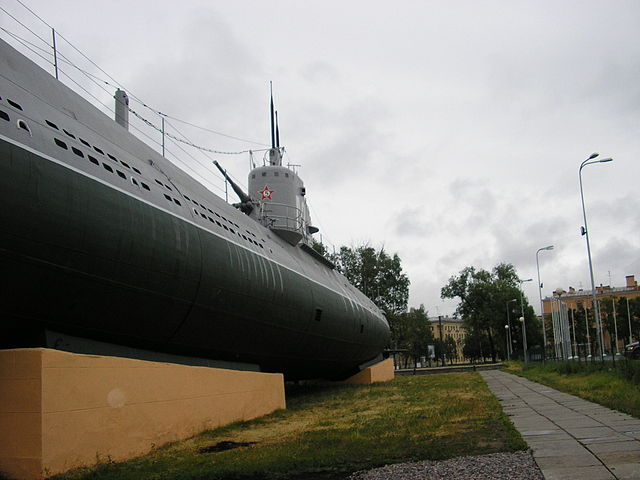
Narodovolets of the Dekabrist class on display at St Petersburg.
The earlier Dekabrist class had two shafts with three-bladed propellers, mated on two 1,100hp MAN/Kolomna diesels, and as auxiliary, two 525hp PG-20 electric motors, plus two electric creeping motors of 50hp each, and 60 DK storage batteries. Performances were average, at 14 knots (26 km/h) surfaced, 9 knots (17 km/h) submerged. To compare, the early Type VIIB were capable of a top speed of 17.7 knots (32.8 km/h; 20.4 mph) surfaced and 7.6 knots (14.1 km/h; 8.7 mph) submerged. So like Holland-types, these Soviet types were faster submerged, giving them on paper better chances of survival. These figures remained the same for the Leninets class, except the Group 3+4 which was propelled by 4,200 hp (3,100 kW) diesels and 2,400 hp (1,800 kW) electric motors at 18 knots (33 km/h) surfaced and 10 knots (19 km/h) submerged.
The very large Pravda class had diesels of a gargantuan model, which together developed 5,400 hp (4,027 kW) while their electric units produced 1,400 hp (1,044 kW). Therefore top speed on the surface was standard, if inferior to other oceanic models, at 20.5 knots (38.0 km/h; 23.6 mph), while submerged it was still good 11.8 knots (21.9 km/h; 13.6 mph).
Also relatively fast were arguably the best and most successful models of the war, the S-class, resulting of a collaboration between Soviet and German engineers. The Hague project, redesignated E-2 had its blueprints sent to Moskow at the end of 1933. By August 14, 1934 as modified and adapted, the design was officially approved for production, designated IX series. The western “Stalinets” class was factice, to make a difference with the earlier “Leninets”. These were quite versatile boats as well, capable of laying mines, but well armed in torpedoes. What is important is their use of German engines and batteries, while the second prototype series used domestically produced machinery. This allowed an upgrade over an earlier powerplant derived from WW1 MAN diesels. The third series introduced further improvements, trying to lower production cost and time, but many remained incomplete during the war.
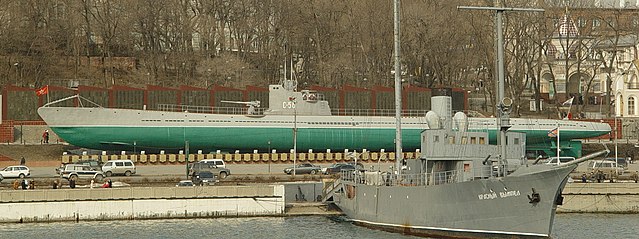
S-56 of the successful S-class preserved at Vladivostock.
The fastest by far were the large oceanic models, fleet submarines called the K-class. They were given 2 large diesel units which developed 8400-hp in total and two 1200 hp electric units each, for a top speed in surface of up to 22,5 knots and 10 knots submerged. But perhaps even better, they could manage far away commerce raiding dur to their 14,000 nm range at 11 knots. They were quite superior to the Type IX U-Boats, which were rated for 4,300 shp and had a couple of SSW 1 GU 345/34 double-acting electric motors which developed 1,000 PS or 990 shp, meaning they were able to reach at best 19 knots surfaced, for a 10,500 nmi (19,400 km; 12,100 mi) range at 10 knots.

Author’s old 1/350 illustration of the L1 (eninec class), serie 2.
What made the Soviet Navy a winner by numbers was a considerable coastal fleet: The average coastal submersibles (‘Schch’ general class) included the four series III units, the fourteen series V, V bis and V bis-2, the thirtry-three series X and the twelve series X bis completed during the war. This fleet of light coastal submarines (Class M) included also the Series VI/VI bis, and series XII/XII bis, the last of which entered service in 1942. The Series XV units entered service well after the German invasion, the first 3 in 1941-42, and 3 others after the war. “medium” series were small enough to be considered extended coastal ones, designed for service in the Baltic and Black sea.
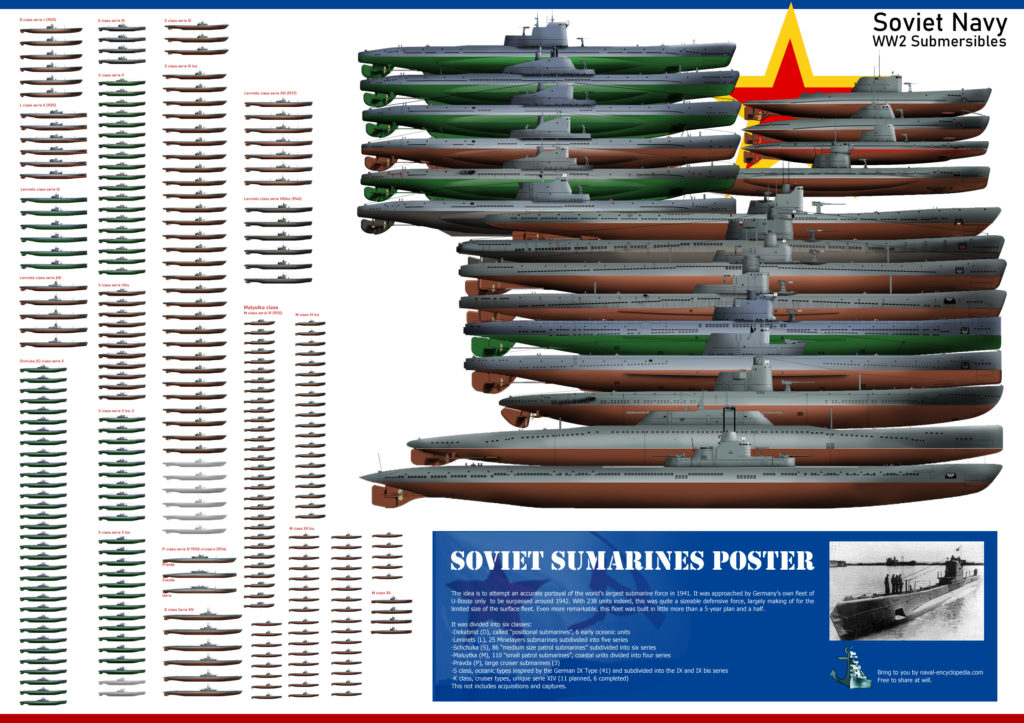
Final poster of soviet submarines in WW2. It shows the scope of the production, all 238 models. Also, like the first one, free to share at will.
Specifics of Soviet submarines

Щ-103 of the Serie V at sea. credits sovboats.ru

Rail Transportation scheme of the M-type
Armament of ww2 Soviet submarines

Author’s old 1/350 illustration of the D4 (Dekabrist class), serie I.
Torpedoes:
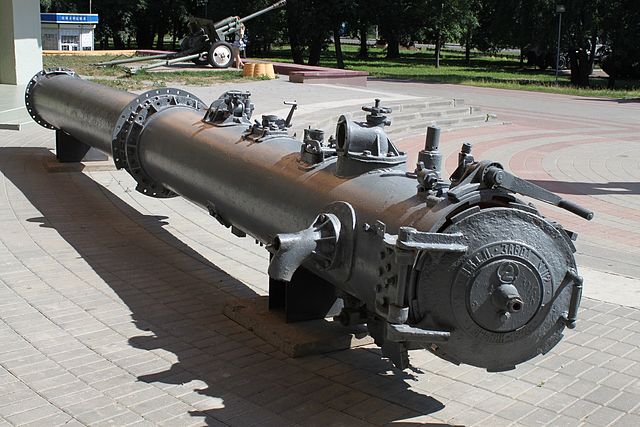
M104 torpedo tube
-Standard 53-27 torpedoes (1927): Based on the earlier model 1912, 456 mm and the next 1917, 533 mm pattern. It was developed domestically in the so-called Ostekhbureau. The 1927 model had a 3,770 lbs. (1,710 kg) warhead, an overall Length of 22.97 feet (7.0 m), and explosive Charge of 584.2 lbs. (265 kg) and a Range of 3,700 m at a top speed of 45 knots. The power was provided by a Wet-heater. Production stopped in 1935. They were allso used by surface ships. When introduced they had a poor range and models from the Whitehead plant in Rijeka (53F) were judged better.
-Standard 53-36 torpedoes: Design started in 1932 to replace the 53-27. First introduced in 1936, basically a modified 53-27 torpedo, quite unsuccessful and production stopped in 1938, just 100 has been delivered.
-Standard 53-38 torpedoes: Design started in 1936 over the Italian 533 mm torpedo purchased from Fiume in 1932 and a copy of the 53F model. It became the standard Russian torpedo of World War II.
Powered by a wet-heater, it carried a warhead 661.4 lbs. (300 kg). The torpedo weighted 3,560.5 lbs. (1,615 kg), and had an overall Length of 23.62 feet (7.2 m). Range was 4,270 yards (4,000 m) and top speed 44.5 knots, less than the 1927 model. But it was much more reliable and went farther, with a larger explosive charge. The engine could be setup to two other ranges and speeds: 8,750 yards (8,000 m) at 34.5 knots and 10,940 yards (10,000 m) at 30.5 knots.
The 53 Family was fairly large and the model 38 alone was declined into several variants: 53-38/53-38U/53-59/53-56V and -56VA models.
-Standard 53-38U torpedoes: Modernized version with a larger warhead (400 kgs). Some had a magnetic fuze, installed from 1942.
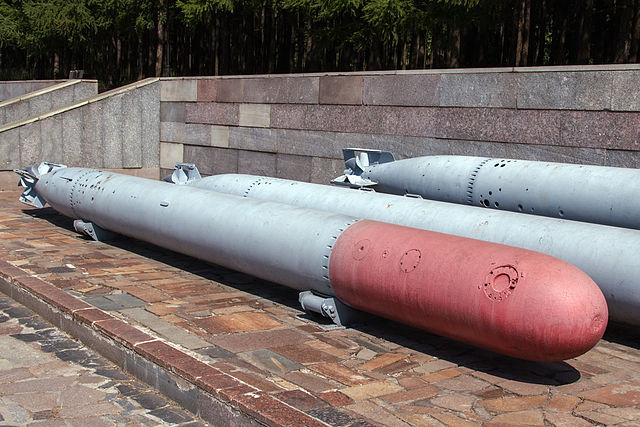
-Standard 53-39 torpedoes: The fastest torpedoes in the world at 51 knots. Propelled by an improved wet heater system they sacrificed range for extra speed and were often carried in submarines alongside standard models. They weighted 3,924 lbs. (1,780 kg) for an overall Length of 24.61 feet (7.5 m), and carried a larger explosive charge of 698.9 lbs. (317 kg) of Trotyl (trinitrotoluene or TNT). Their settings were: -4,370 yards (4,000 m)/51.0 knots, 8,750 yards (8,000 m)/39.0 knots and 10,940 yards (10,000 m)/34.0 knots.
-Electric ET-80 torpedoes: The first electric torpedoes denominated 533 mm (21″) ET-80, designed in 1939 but introduced into service by 1942-43, exclusively for Russian submarines. They weighted more than conventional models due to batteries, at 3,968.3 lbs. (1,800 kg) for an verall Length of 24.61 feet (7.5 m) and carried a large 881.8 lbs. (400 kg) warhead up to 4,370 yards (4,000 m) at 29 knots but left no bubbles track, which compensated fo the lack of speed.
Russian naval aviation used the -450 mm TAV-15 (1932): An Aircraft torpedo based on the shortened Pattern 1910/15 torpedo, launched from 6,500-9,800 feet (2,000-3,000m), with 3 drogue parachutes and the TAN-12 (1932). In 1939 they were gradually replaced by the wartime 45-36AV-A model. There has been planes to carry planes on large cruiser submersibles in the Pacific, but they were never realized.
-Oceanic, station and medium models:
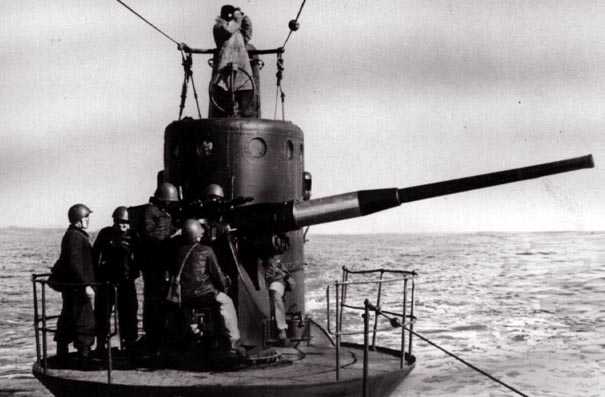
100 mm B-24 being fired – credits navweaps.com. This was the grand standard of submersible deck guns in Russia during the interwar and WW2.
The standard revolved around the 100 mm caliber. Compared to WW2 German standard, this was better on paper than the 88 mm. However both optics and rate of fire limited its effectiveness.
100 mm/51 (3.9″) B-24:
Thos was the product of a request of 1932 by the admiralty to the “Bolshevik” factory to design and manufacture a new 100 mm (3.9″) gun, mainly for submarines used, ans small crafts. The prototype was ready by 1935, trials lasted until 1936 and it was accepted in to service.
In 1937, it was modified and redesignated B-24-IIc, and in 1938 it was lengthened to 56 calibers, re-rested and accepted into service in 1939. This new standard was called 100 mm/56 (3.9″) B-24BM Pattern 1939.
This 1939 pattern used a gun shield but was reserved for small crafts. A few of these B-24 guns were made additionally (5) but 63 more after the war, all for new submarines. The base was an A tube, fastened with a hot hammered casing. The B-24BM used loose-liner tube, casing casing and breech. Semi-auto Breech block mechanism, pneumatic power with horizontal sliding. However after 1942, it shifted to a spring-driven, semi-automatic breech. They also differed by the gun sight and shield. This model was also used (two guns) on the very large Pravda class.
-M-Boats and other coastal models:
In standard, they carried two standard 21-in TTs and a single 45 mm (2 in) semi-automatic gun
45 mm/46 (1.77″) 21-K: This gun was developed from the standard Army 45 mm Pattern 1932 anti-tank gun, placed on a navalized mount and with a semi-automatic breech. Tested in 1934 it was accepted into production but manufacturing limitations prevented the adoption of automatic breech mechanisms before 1935. It became also the standard AA mount until 1941-42, replaced by the much faster 37 mm/67 autocannon. In AA use, it was not very successful due to its semi-automatic nature and absence of a time fuze. River monitors received 40-K turreted mount and 41-K twin mount. Overall a grand total of 2,799 of such guns were manufactured until 1947.
-Light AA: 25 mm/79 (1″) 110-PM
Also used on soviet submarines was the typical tandem-tube 84-KM which, designed in 1943-44, which helped to create the 110 PM, developed in 1945, tested in 1946 and accepted into service in 1947. It is related to immediate postwar submersibles and manufacture went on until 1984, so most of the cold war. It became standard on the Zulu, Whiskey and Quebec classes.
Minelayer models (Leninec class):
These only minelayer models were based on the British L-class HMS L55, sunk during the British intervention in the Russian Civil War, refloated and “reversed engineered”. They were of the saddle tank type and mines were carried in two stern galleries. The concept however by pioneered by the Russian submarine Krab before WW1.
In addition to the bow TTs, stern TTs in some cases, 100 mm and 45 mm guns, they carried 20 mines and sank many ships, Vladimir Konovalov (1943-1945) being considered an ace commander.
Soviet submarines in action during WW2
Performances of this large submersible fleet in WW2 remained nearly without highlights, just like the entire Red fleet. A few German, Finnish, or other axis vessels (in the Black sea) were lost to Russian submarine attacks while suffering much heavier losses. Poor performances caused probably both because of not the best equipments, but overall poor training and command, following the great purges ordered by Stalin, that decapitated his submersine staff as well. The boats however were not really at fault. Alson the relative lack of targets and weak traffic (compared for example to the situation in the Atlantic) explains in part while Soviet submariners seldom found any target, and if spotted, did not properly acted.
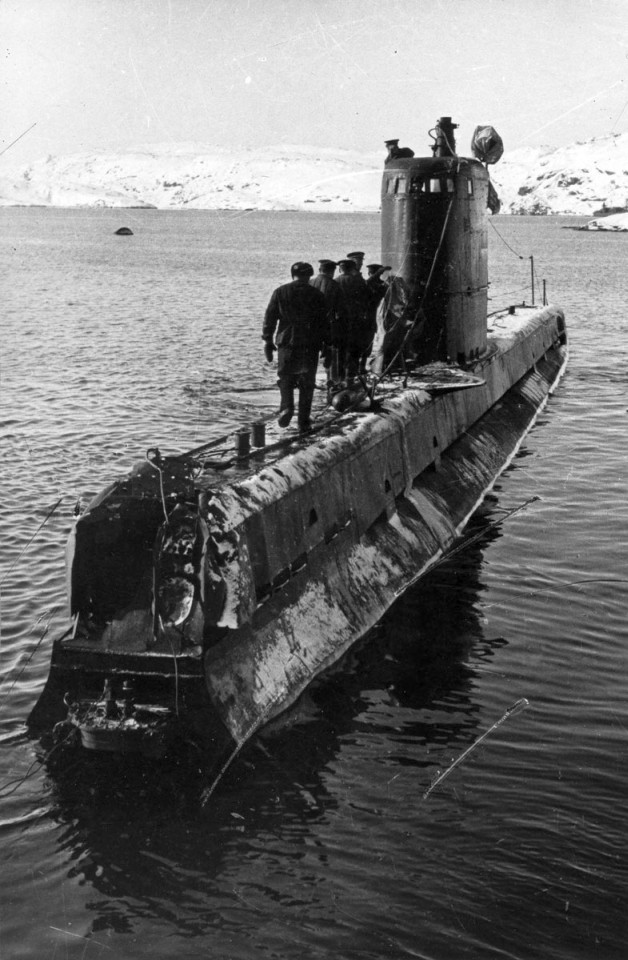
Soviet submarine M-174 badly damaged by a mine in the arctic: The bow was decapitated but the boat survived thanks to its compartimentation and the pressure hull was not fractured. Src: http://wio.ru
Among others, SC 305 was rammed and sunk by Finnish U-Boat Vehehinen in 1942 and an Italian MTB torpedoed SC 214 in the Black Sea in surface and in total 34 boats of the ShCh class were sunk in action. The Soviet Navy hat large did met a few successes against the dreaded German U-Boats, as two were ‘surely’ sunk, by a submarine, and depth charges, four more uncertain. Three U-boats were heavily damaged, either by depth charges and ramming. In the Arctic Lend-Leased ships and aircrafts such as the Catalina and B-25 Mitchell in Soviet Navy service managed to damage German U-boats or at least make them “keep their head underwater.
Soviet submersible successes
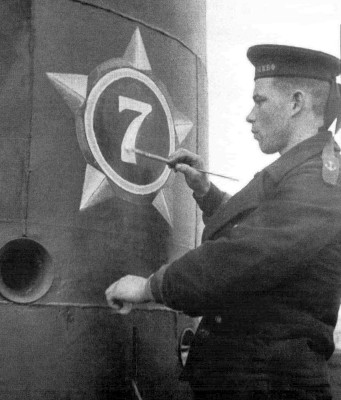
5 Victories painted on the conning tower of L-3. Src: wio.ru
Common awards were the Guards Badge and/or Order of the Red Banner. Flags were displayed on the coning tower together with the fleet flag and Navy flag. Like in other arms, patriotic slogans were also often painted on the conning tower, but rarely individual badges, like found on British and German submersibles, to the expense of a certain “esprit de corps” in the crew. However successful sub captains were individually promoted, and there were indeed, quite a few Soviet submarine aces.
Soviet submersible aces
-Polyakov Yevgeniy Petrovich (L4, Black Sea Fleet, 9 victories)
-Mogilevsky Sergey Sergeyevich (L21, Baltic fleet, 9 victories)
-Greshilov Mihail Vasilievich (M35 and ShCh-215, Black sea fleet, 9 victories)
-Avgustinovich Mihail Petrovich (K1, Northern Fleet, 8 victories)
-Vlasov Vladimir Yakovlevich (ShCh-214, Black Sea, 6 victories, sunk by MAS-571 in 1942)
Other commanders with 5 victories included Grishchenko Petr Denisovich, Konovalov Vladimir Konstantinovich, Schedrin Grigoriy Ivanovich, Lisin Sergey Prokofievich, Lunin Nikolay Alexandrovich. Many more made 2 to 4 kills during their carrer. Other notable commanders included the infamous Marinesko Alexander Ivanovich which sank the German liner Wilhelm Gustloff (25484 GRT), with the greatest losses of life for a sinking ship in WW2, and General Steuben (14660 GRT). Pavel Ivanovich Bokarov also sank more than 13000 GRT of shipping. In the Pacific, Fedor Grigorevich Vershinin and Anatoly Stepanovich Kononenko which sank the Japanese transport Taito Maru (887 GRT) and badly damaged the Auxiliary gunship Shinko Maru n°2 in 1945. Mines also caused quite many losses to German forces: L3, of commander ace Vladimir Konovalov (1943-1945) for example sank with torpedoes the German transport ship Goya (1945) and Swedish C.F. Liljevalch (on 18 August 1942) but also claimed with mines 14 vessels from 1941 to 1945, in total 30,965 GRT. But the L3 was only the 12th best Soviet submarine by torpedo score.
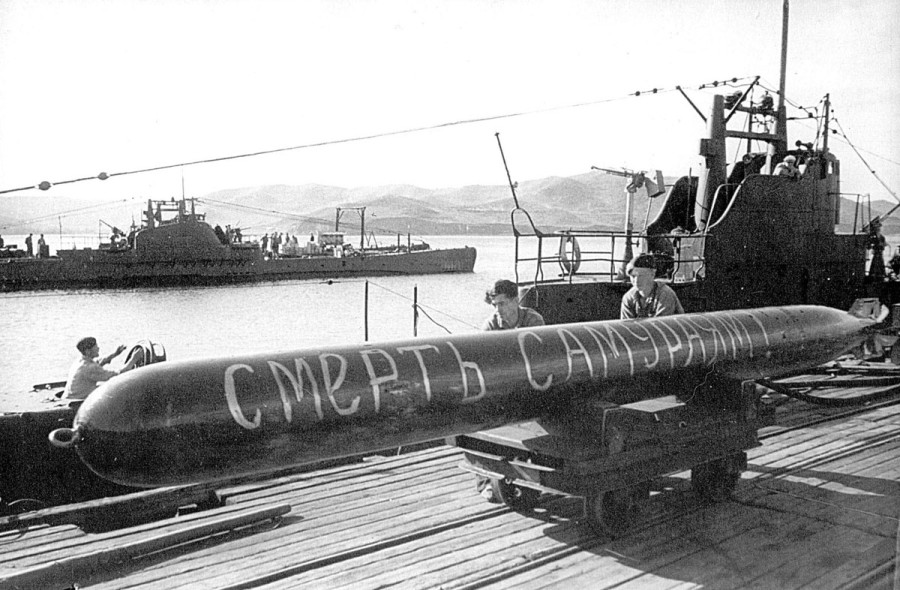
Shch 218 of the Pacific fleet receiving a torpedo with the slogan “death to the samurai”. Despite of the motivation there is not a single case of IJN vessel sunk by the Soviet submarine. Src: http://wio.ru
Before the cold war: Projects and influences
When the war ended in 1945, USSR obtained as part of the peace treaty a number of axis submarines as war reparation.
Read more/Src
On sovboat.ru
//wio.ru/fleet/ww2subm.htm
//ww2-weapons.com/submarines-scuka-class/
//www.navweaps.com/Weapons/WTRussian_WWII.php
//www.navweaps.com/Weapons/WTRussian_Main.php
//en.wikipedia.org/wiki/Shchuka-class_submarine
//sputniknews.com/viral/201905061074735839-lost-soviet-submarine-found-gulf-finland/
//en.wikipedia.org/wiki/Category:World_War_II_submarines_of_the_Soviet_Union
//wio.ru/fleet/subm-balt.htm
//en.wikipedia.org/wiki/List_of_Soviet_and_Russian_submarine_classes
//weaponsandwarfare.com/2015/03/02/soviet-union-wwii-submarines/
//forum.axishistory.com/viewtopic.php?t=117516&start=120
//wio.ru/fleet/subm-blk.htm
//www.deepstorm.ru/DeepStorm.files/17-45/p%20IV/list.htm
//www.sovboat.ru/ship/p1.php3
//book.uraic.ru/elib/pl/lodki/pravda.htm
//tsushima.su/forums/viewtopic.php?id=1357&p=1
//vpk-news.ru/articles/44900
//russiannavy.net/militaryPhotos/subsColors/Color.jpg
//farm1.staticflickr.com/955/41570622814_4cf4ae2aa3_o.jpg
//www.aviapress.com/magaz/mkl/mkl201010_1.jpg
//www.aviapress.com/viewonekit.htm?MKL-201010
//en.wikipedia.org/wiki/Soviet_K-class_submarine
//www.navweaps.com/Weapons/WNRussian_Main.php
//www.sovboat.ru/ship/mxv.php3
//www.deepstorm.ru/DeepStorm.files/17-45/m%20VI/list.htm
//book.uraic.ru/elib/pl/lodki/pravda.htm
//uboat.net/allies/warships/class/214.html
//www.deepstorm.ru/DeepStorm.files/17-45/p%20IV/list.htm
3D Corner
sketchfab.com/3d-models/diesel-submarine-type-m-baby-xii-series-63f9919dbd6042a5841a36c97bc73a2a
//www.cgtrader.com/3d-models/watercraft/military/k-21-wwii-soviet-submarine
//www.diecast.es/en/submarine-s13-atlas.html
Nomenclature of WW2 soviet subs
Oceanic Series I -Dekabrist class (1928)
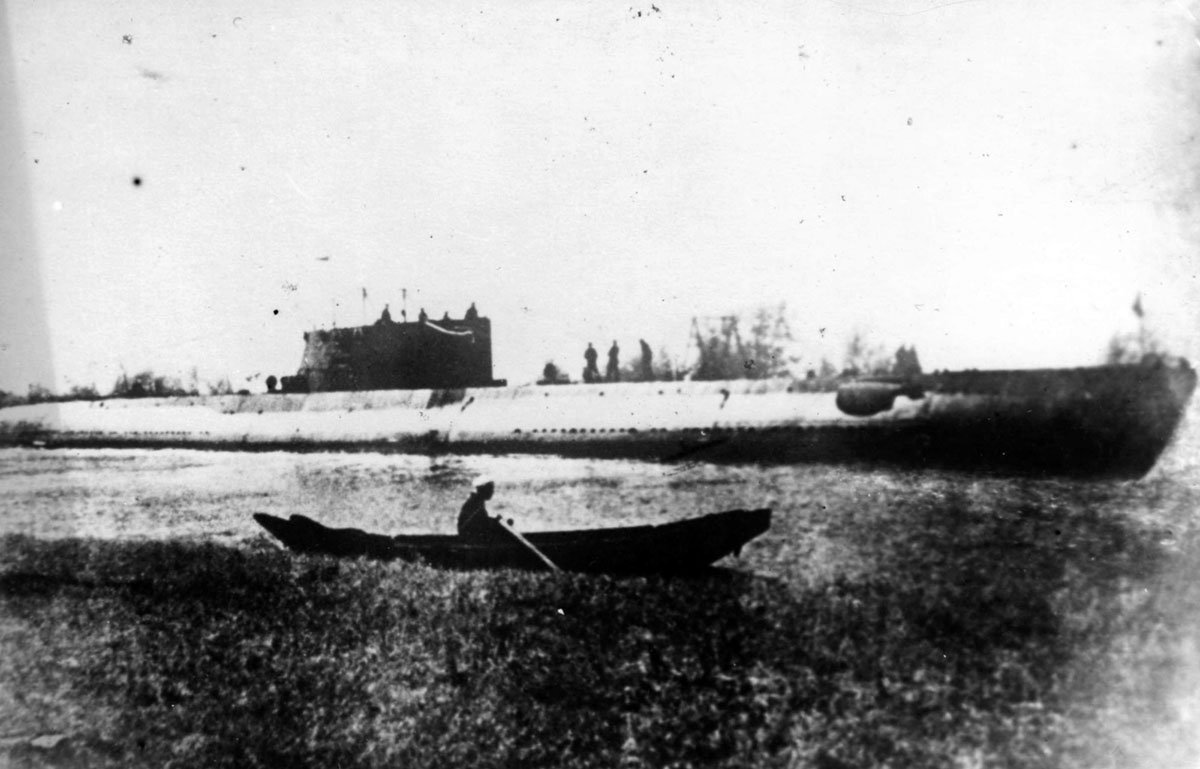
Dekabrist-I – credits sovboats.ru
Main class of Russian ocean submersibles in 1941, she was also the oldest. In this regard, the last units designed were the B, G, and V of the Tsarist fleet, designed and started in 1916-17, but never completed due to the civil war. They were taken under the strong influence of the American engineer John Holland, one of the great pioneers of this field at the beginning of the century. In 1925-26, Soviet engineers started again from very old references: The 10 Bars class designed by Bubnov, and 4 type AG designed on Holland plans.
Three sets of six units were therefore designed with a certain amount of time between them, in order to draw lessons from their exercise design. The first, the D1-6 or series I, also bore the names of personalities of the Party. These units had suffered from design flaws, such as the compartmentalization of part of the engine, complicating maintenance and risking overheating, as well as more general quality problems, which were common in the Soviet industry. time.
Their immersion time was also too long, making it very vulnerable, a defect that was quickly corrected. They plunged to 91 meters in operations, were fast, good walkers, and holding the sea quite well. They were modernized extensively in 1940. During the conflict, three of them were lost at sea in the Northern Fleet , based in Arkhangelsk. The D4 was sunk in 1943 by two captured U-Bootes (UJ-102 and 103). The last two survived until the end of the 1950s.

New (above) author’s illustrations. The top one is based on the CC profile is therefore stays under CC licence. Same for the following.
Specifications
Displacement: 933t surface, 1351t diving
Dimensions: 76 x 6.50 x 3.80 m
Propulsion: 2 shaft diesels and word. elect., 2600/1600 cv.
Speed: 14/9 knots surface / dive.
Crew: 53
Armament: 8 x 533 mm TTs (6 bow, 2 stern), 1 x 100 mm, 1 x 45 mm AA, 1 x 12.7 mm AA.
Leninets-class oceanic Series II (1931)
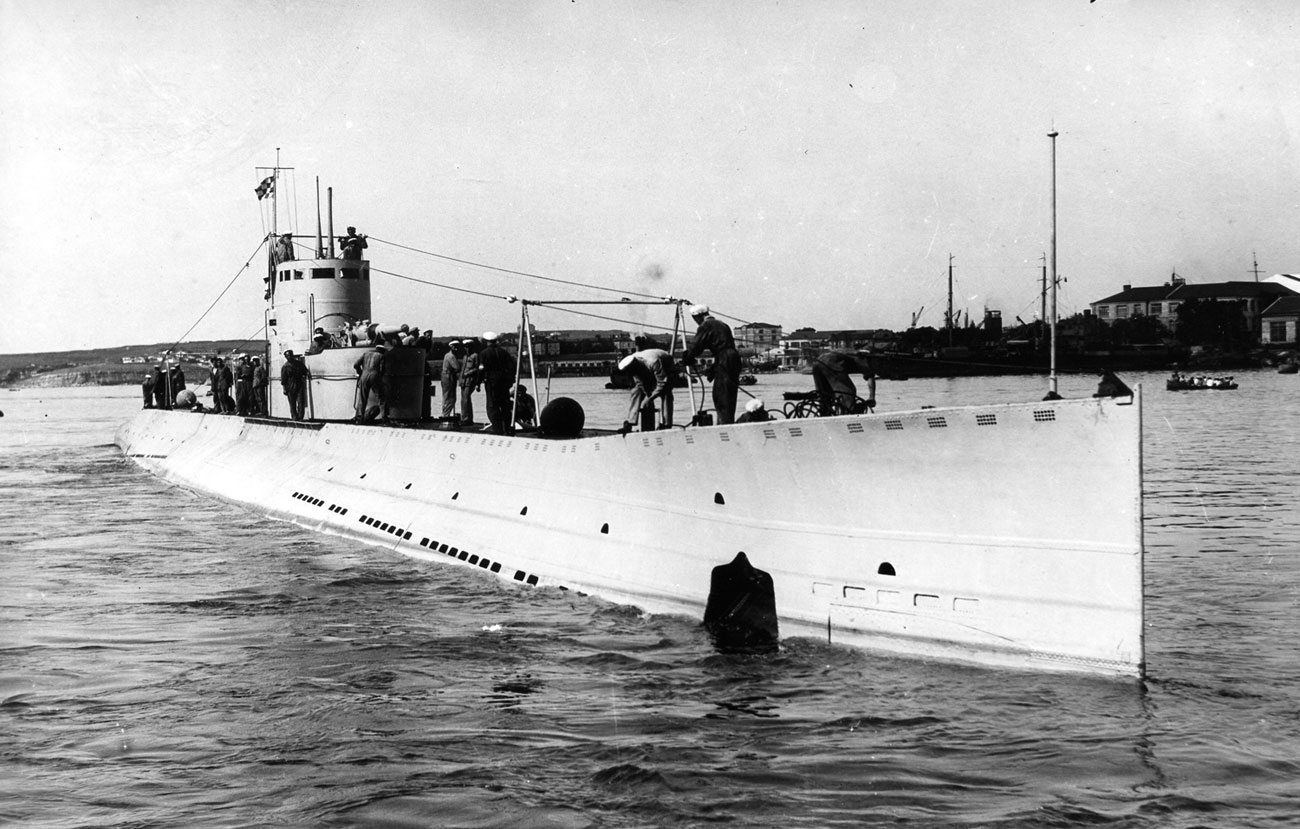
Serie II, I-4 credits sovboats.ru
This draft of the Serie I was very useful for the series II, the L1 to 6. But these were mainly inspired by a British submarine of the class L, the L55, sunk in 1919 during the civil war, then bailed out, repaired , and reintegrated into the Soviet Navy in 1931 under the name of Bezbohnik. The Serie II thus had a different ballast, a raised bow, no engine compartment, a tub tube in the British fashion, and its 6 tubes in the bow. Last but not least, they had two mine tubes, long enough to store ten each, at the rear of the hull, closed by an underwater hatch. A configuration similar to that of 1910 Krab, the first of its kind in the world.
In operations, three were lost, two of them in 1941 (one by mines, the other by German batteries on the Neva), and one sunk in the Black Sea (off Costanza) in 1944 by the UJ-104.
Specifications
Displacement 1,051 t. standard -2,327 t. Full Load
Dimensions 81 m long, 6.60 m wide, 4.18 m draft
Machinery 2 shaft diesels and electric mot. 2200/1050 hp
Top speed 14 knots surface/9 knots underwater
Armament 1x 100mm cannon, 1x 45mm AA gun, 6x 533mm TTs, 20 mines
Crew 54
Leninets-class oceanic Series XI (1935)
This improved class comprised six units numbered L7-12
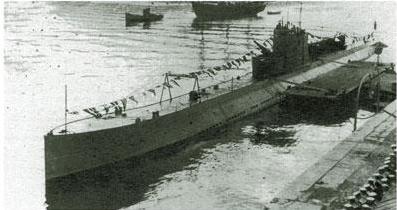
L-4 Garibaldiec (cc)
Specifications
Displacement 1,051 t. standard -2,327 t. Full Load
Dimensions 81 m long, 6.60 m wide, 4.18 m draft
Machinery 2 shaft diesels and electric mot. 2200/1050 cv.
Top speed 14 knots surface / 9 knots dive
Armament 1x 100mm cannon, 1x 45mm AA gun, 6x 533mm TTs, 20 mines
Crew 54
Leninets-class oceanic Series XII (1938)
Seven ships were built of this third group (L13 to L19), launched from 1937 to 1938, assigned to the Pacific Fleet. They were considered a brand new project, as the hull was based on the Srednyaya class, and carried carried 18 mines. All but two survived the war. L16 had the most unusual end, torpedoed by the Japanese I-25 on 11 October 1942, near the coast of Oregon, while in transfer to the Soviet Northern Fleet.

Class Leninets – Serie XI L-12 Molotovets
Specifications
Displacement 1,051 t. standard -2,327 t. Full Load
Dimensions 81 m long, 6.60 m wide, 4.18 m draft
Machinery 2 shaft 2 diesels and electric mot. 2200/1050 hp.
Top speed 14 knots surface / 9 knots dive
Armament 1 100mm cannon, 1 45mm AA gun, 6 TLT 533mm, 20 mines
Crew 54
Pravda-class Oceanic Series IV (1934)
Studied in 1929 under the first five-year plan, these wing units, similar to those designed by the Japanese, suffered from poor design, although their construction lasted five years. Their hull was too light, badly compartmentalized, they were excessively noisy, slow, not very marine and easy to handle. In addition they were poorly armed, with only six tubes and ten torpedoes shipped, despite relatively generous dimensions. Finally, their batteries did not charge fully until twenty hours, leaving them vulnerable during this time.
This failure made it possible to stick to the three authorized units, the Pravda, Zvezda and Iskra, also used as transport, demoted to the second line. Only Pravda was sunk during the war, jumping on a mine in September 1942, the other two being badly damaged in front of Leningrad by the Luftwaffe or the German artillery.

Pravda-class submarine cutaway blueprint

Serie IV Pravda, withough gun shields, 1945
Specifications
Displacement 1,200 t. standard -1 870 t. Full Load
Dimensions 90 m long, 8 m wide, 3.10 m draft
Machinery 2 propellers, 2 diesels MAN and word. elect., 5400/1000 cv.
Top speed 18.5 knots surface / 7.7 knots diving
Armament 2 guns of 100, 1 of 45mm AA, 6 TLT 533 mm (4 bow, 2 stern, 10 torpedoes)
Crew 54
S-class Oceanic Series IX & IX bis (1935)
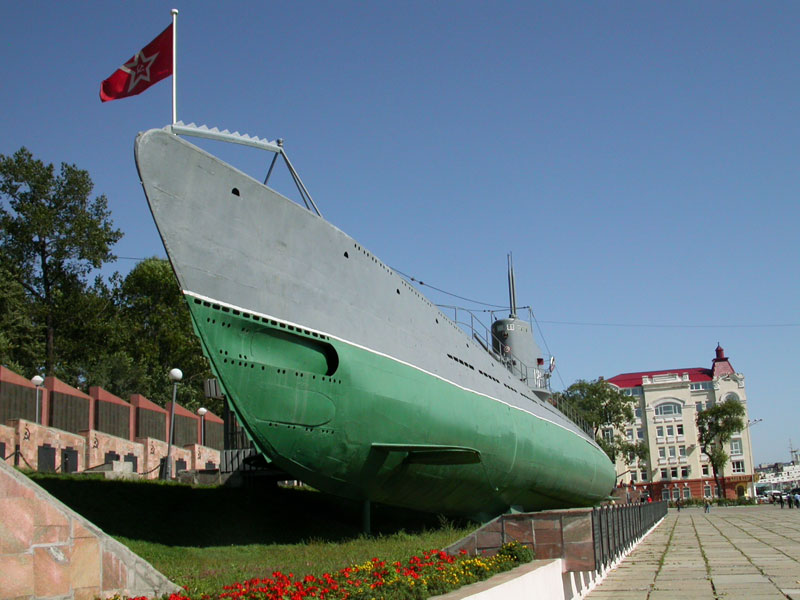
Designed with the close assistance of the German office of the Hague, the famous Ingenieurskantoor voor Scheepschouw, under cover of research for the Navy Batavian, that were conceived several future formidable U-Bootes of the Kriegsmarine, thanks to the needs of certain countries, as Turkey, Finland, Spain and the Soviet Union.
The latter received the plans of the series Ia and copied them literally to the bolt near Ordzonikidze. The first three of the IX series were launched in 1935-36. They served to define the mass construction of the following type IXa units, in several slices, comprising 17, 27 and 6 units, with another 10 (Series XVI) waiting. But of this mass, only one-third was operational at the time of the June 1941 invasion. The others entered service during the remainder of the conflict.
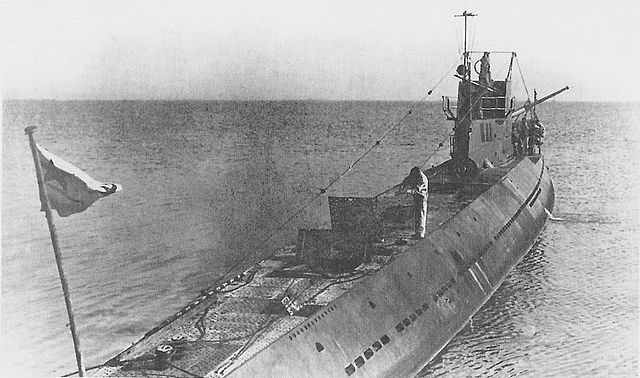
S7, stern view.
Some were built in Krasnaya Sormovo, Gorky, in the Moscow suburb, then towed on the Neva to Leningrad for completion. They had many qualities, fast, manoeuvring and solid, and were probably among the best units in the fleet. Most were affected in the Baltic, and others in the Arctic. The figures differ, but between 35 and 37 units were admitted to service during the war. Of these, at least 16 were in service in June 1941.
The S13 was decorated for having – the controversy of historians still raging – sank two German steamers fleeing in 1945 the front and losing 7900 people (soldiers probably mixed with the civilians). 16 will be sunk in combat, four awarded to China in war damage in 1955, and one preserved.
Specifications
Displacement 856 t. standard -1 090 t. Full Load
Dimensions 77.75 m long, 6.40 m wide, 4.06 m draft
Machinery 2 shaft diesels and 2 mot. elect., 4000/1100 cv.
Top speed 19 knots surface / 8.8 knots dive
Armament 1 x 45, 1 x 7.7 mm AA, 6 x 533 mm TTs (4 bow, 2 stern, 12 torpedoes)
Crew 45
Leninets-class Oceanic Series XIII/XIII bis (1937)
Improved versions of the previous series II and XI, the 6 units of the XIII series (L13 to 19) will be born in 1937-38. The hull was enlarged, the power doubled, and the speed and autonomy increased in proportion. They served in the Pacific fleet, but returned to the Baltic and the Northern Fleet after the invasion. It was during this trip that the L16 was mistakenly torpedoed by the Japanese submarine I-25, in November 1942, off the American coast.
The passage through the Panama Canal was part of this journey. The L13 was also sunk in the Pacific. The following XIII bis were ordered at the beginning of the hostilities, including the L20 to 25. Launched in 1939-41, but completed at the time of the invasion for the last, they constituted an integral recovery of the previous design. Three were lost in action, two of them in 1944.
Specifications
Displacement 1,123 t. standard -1 416 t. Full Load
Dimensions 83.30 m long, 7 m wide, 4.80 m draft
Machinery 2 shaft diesels and word. elect., 4200/2400 cv.
Top speed 18 knots surface / 10 knots dive
Armament 1 x 100, 1 x 45, 2 x 12.7 mm AA, 8 x 533 mm TT (6 bow, 2 stern), 20 mines
Crew 55
K-class Oceanic Series XIV (1938)
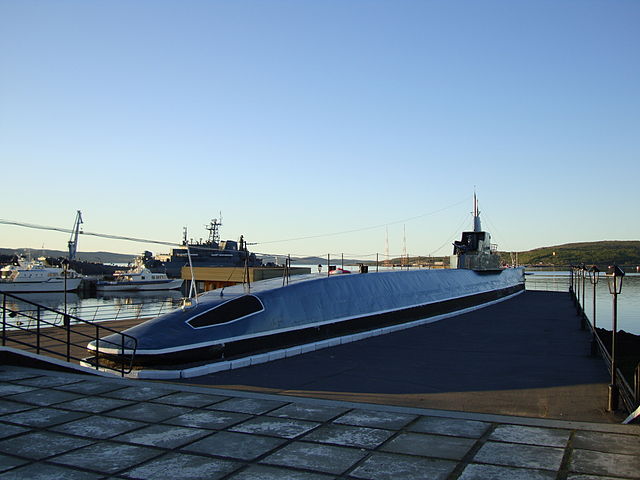
Preserved К-21 today, central square of Severomorsk, Murmansk Region, Russia.
The Series IV units proved extremely disappointing, making the Soviets sceptical about their ability to design fast squadron submarines alone. However, the Admiralty demanded it, and 12 buildings of a new type were approved under the Third Plan, begun in 1936-38 and completed during the war. Specially designed for the Baltic, they suffered from none of the faults of the previous ones and were in many respects even the best Soviet submarines of that time.
Their seven-compartment double hull was much more spacious and solid, and it was even a question of time to equip them with a reconnaissance seaplane. This space allowed them to opt for a doubling of power, and thus the projected speed (22.5 knots) was almost reached, as well as the autonomy of 14,000 nautical miles. They also carried 24 torpedoes, divided between 10 tubes, 2 at the rear surface, and 20 mines in horizontal tubes.
12 units will be built, but all were not in use in 1941 during the invasion: less than 10 units were in this case. Four will be transferred in 1940-41 in the Arctic. Two will be completed in 1945 and five will be lost in action in 1942-43.
Specifications
Displacement 1,490 t. standard -2,600 t. Full Load
Dimensions 97.65 m long, 7.40 m wide, 4.51 m draft
Machinery 2 shaft diesels and electric motors, 8400/2400 hp.
Top speed 21 knots surface / 10 knots dive
Armament 2 x 100, 2 x 45mm AA, 10 x 533 mm TTs (6 bow, 4 stern, 24 torpedoes)
Crew 60
Shchuka class Coastal Series III (1930)
First of a long and prolific series of medium coastal submersibles, the Schch 301 to 304 were four units defined in 1929, of which one offered by public subscription. They had some defects, being slow enough with a range of between 6500 and 9000 nautical miles on the following series. Three were lost in the Baltic Sea, including the Juminda Dam.
Specifications
Displacement 578 t. standard -704 t. Full Load
Dimensions 57 m long, 6.20 m wide, 3.80 m draft
Machinery 2 shaft diesels and electric motor 1370/800 hp.
Top speed 12.5 knots surface / 8.5 knots dive
Armament 1 barrel 45, 2 ML 12,7 mm AA, 6 TLT 533 mm (4 bow, 2 stern)
Crew 35
Shchuka class coastal Series V/V bis (1933)
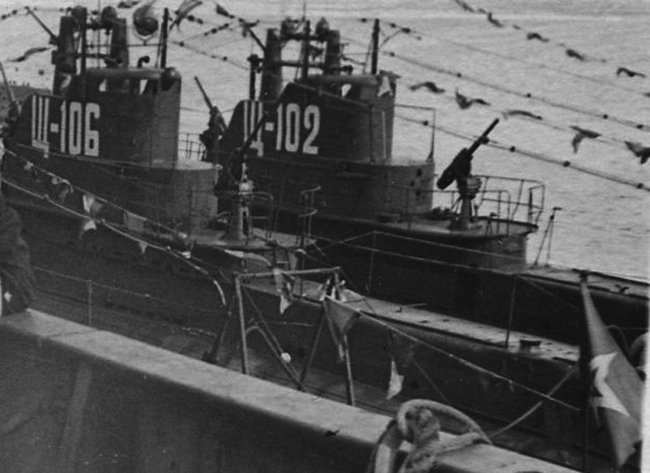
Boats 106 and 107 of the serie V – credits sovboats.ru
Series of mass construction (19 series V, 12 series V bis and 9 series V bis-2, for a total of 40), they broadly resumed the precedents of series III. Their booth, however, was different, their hull deeper, they wore a stronger DCA. The figures diverge but it seems that eight were lost in action, most of them on mines, of which the Gulf of Finland was literally infested. The Schch 305 had a fate for the less moose, if not fatal: it was rammed and sunk by the Finnish Submersible Vehinen November 5, 1942.
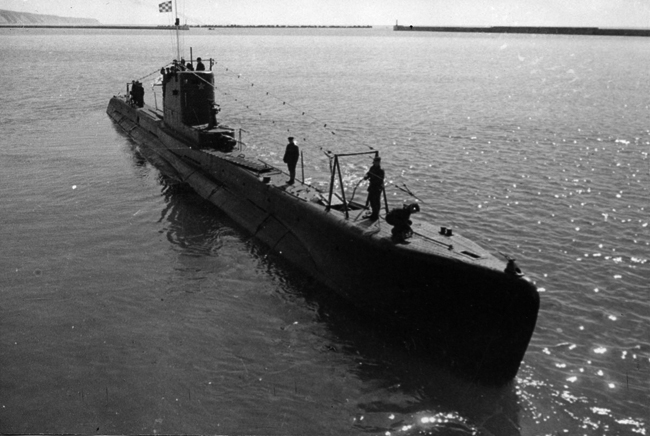
H201 of serie Vbis
Specifications
Displacement 589 t. standard -708 t. Full Load
Dimensions 58.50 m long, 6.20 m wide, 4.30 m draft
Machinery 2 shafts diesels and electric motors, 1600/800 hp.
Armament 2 x 45, 1 x 12.7 mm AA, 6 x 533 mm TTs (4 bow, 2 stern, 10 torpedoes)
Crew 40
Shchuka class Series VI/VI bis (1933)
First of a long and prolific series of light coastal submarines, the M1 to 28, M51 and M52, were 30 units defined under the first five-year plan, and intended for the Pacific fleet (except the M51 and 52, remained at sea black, despite a short assignment in Caspian). Among the lightest of the time while being solid and spacious, far from the pocket submarines that the Axis invented and used during the conflict, they only had two torpedo tubes in the bow, without refills it seems.
They were designed to be built in a complex located in the Eastern Urals, well inland therefore, and transported for final assembly and completion by rail, each of which can be stored in sections on large wagons limited to 120 tons of cargo. load: These units were therefore ultimately limited to this tonnage. Units completed in the Black Sea made their tests and were again dismantled for transport to Vladivostok.
Of a reduced military value and especially unable to cope with the North Pacific sea conditions, these units saw little fighting. 5 will be transferred to the Black Sea. None were lost in combat, and all were withdrawn from service between 1947 and 1952. The VI bis, built in 1934-36, differed from the first, being built this time by more experienced shipyards at Nikolayev and Leningrad. 20 will be built, with a remodelled tower to improve their hydrodynamics. They were M53 to M56 and M71 to M86. 4 will be transferred to the Pacific, 3 will be sabotaged in June 1941 to avoid capture, 7 will be sunk during the war in the Baltic. The M74 to Kronstadt by bombers and the M78 by the U-144 on the coast of the Lithuanian in June 1941.

Original plans of the serie VIb – credits http://www.deepstorm.ru
Specifications
Displacement 160 t. standard -200 t. Full Load
Dimensions 37.81 m long, 3.13 m wide, 2.58 m draft
Machinery 2 shafts diesel, 1 electric motor, 685 hp.
Top speed 13 knots surface /6 knots sub
Armament 1 x 45 mm, 2 x 533 mm TTs (stern)
Crew 16
Shchuka class coastal series X/X bis (1936)
Last series of average coastal mass construction (33 series X, 13 series X bis, for a total of 46.), they resumed in their main lines the precedents of the series V. Their kiosk was however different, with a heavy machine gun additional, and better sound insulation: The precedents were real vibration generators, very easily spotted by German and Finnish submersible hunters.
In addition they were slightly faster diving. It seems that 22 were lost in action. The later X-Series units were launched from 1939-40, and several in 1941. Two more were demolished in their building basin. They did not possess the heavy machine guns of the first series.
Specifications
Displacement 590 t. standard -708 t. Full Load
Dimensions 58.75 m long, 6.20 m wide, 4.30 m draft
Machinery 2 shaft diesels, electric motors 1600/800 hp.
Top speed 13.6 knots surface / 8.7 knots dive
Armament 2 x 45, 2 x 12.7 mm AA HMGs, 6 x 533 mm TTs (4 bow, 2 stern, 10 torpedoes)
Crew 40
Malyutka class Medium Series XII/XII bis (1936)
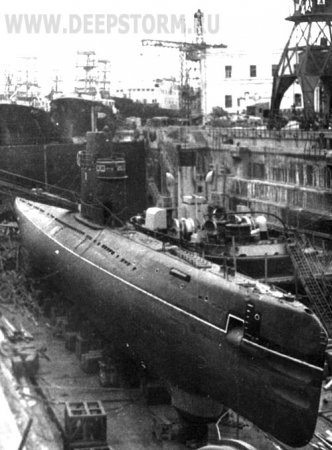
M351, credits deepstorm.ru
Second series of light coastal submersibles, built in mass, the units of this series did not have as imperative to be able to settle only on rails in prefabricated sections. Therefore, it could be larger, better armed, among others. In fact, they mainly benefited from a doubling of their autonomy, going to nearly 2000 nautical miles. built in Leningrad, the first four (Series XII) were accepted into service in 1938. Three will be transferred to the Arctic in 1939, and renamed M171, 172 and M401. The second jumped on a Barentz sea mine in 1943.
The 45 units of the next mass series, the XII bis, will be equipped with new kiosks and larger oil tanks (3000 nautical miles). They were built in three yards and assigned to the Baltic. 17 will be lost in combat. In 1938, a ship of this type was taken for experimentation on new closed-circuit diesel engines (patent of Dr. Walter). But it was never operational, and trials continued after the war.
Specifications
Displacement 210 t. standard -261 t. Full Load
Dimensions 44.50 m long, 3.30 m wide, 3.07 m draft
Machinery 2 propellers, 1 diesel and 1 word. elect., 800/400 hp.
Top speed 13.5 knots surface / 7.7 knots dive
Armament 1 x 45 mm ???
Malyutka class Coastal Series IV (1940)
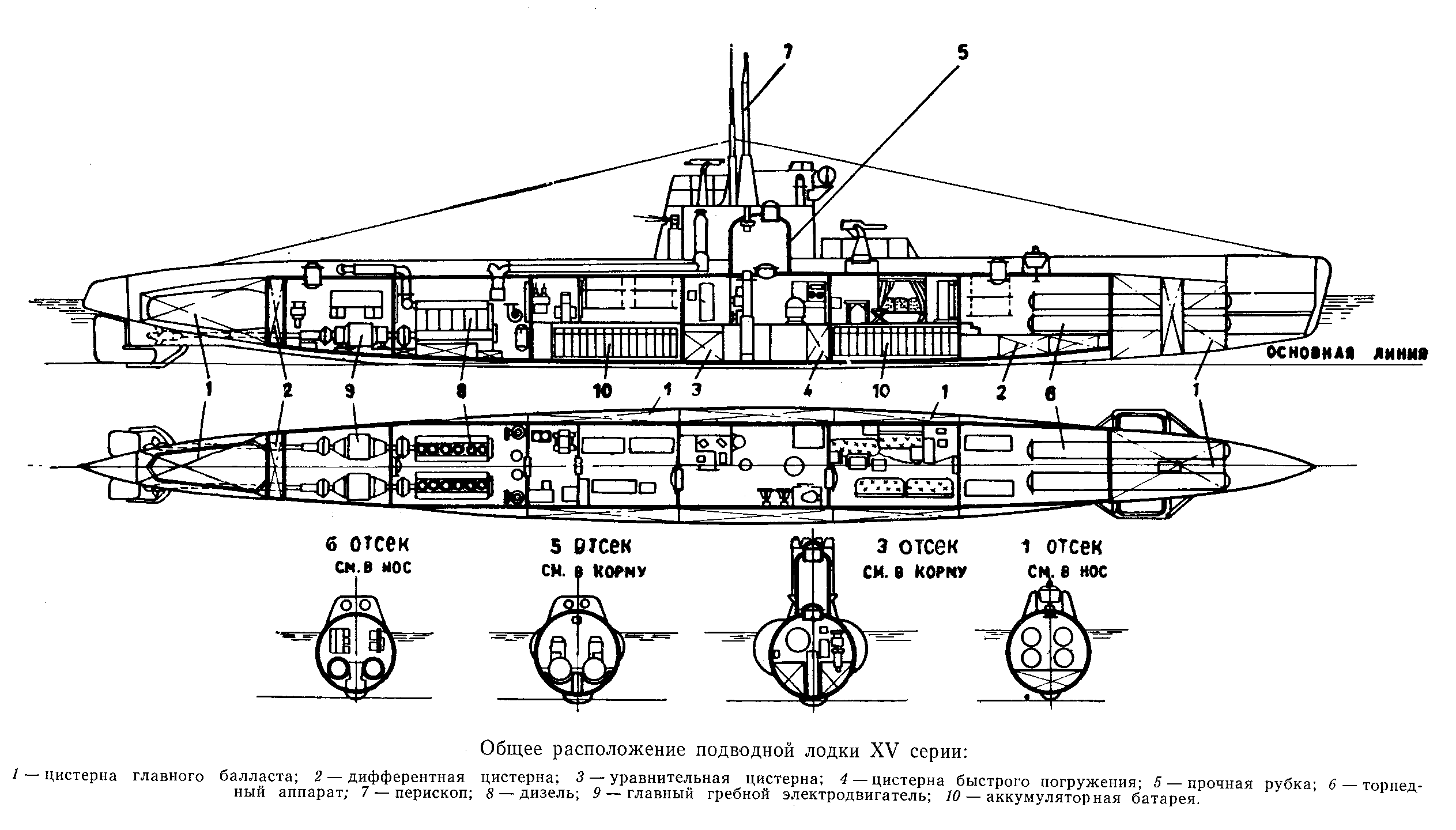
M-class blueprint serie XIV, credits deepstorm.ru
The latest series of light coastal submersibles, the XV series included 4 torpedo tubes instead of 2, all in bow, as well as a larger hull, two machines, a better speed and a range of 3000 nautical miles. They were diving at 80 meters in operation. They were built in Leningrad, but they were built too late: Only three were in service early enough to take part in the conflict (M200, 202 and 203), three others will be completed after the war and the rest will not even be started.

Specifications
Displacement 281 t. standard -351 t. Full Load
Dimensions 49.50 m long, 4.40 m wide, 2.75 m draft
Machinery 2 propellers, 2 diesels and 2 electric motors 1600/875 hp.
Armament 1 x 45, 2 x 7.7 mm AA MGs, 4 x 533 mm TTs (stern)
Crew 24

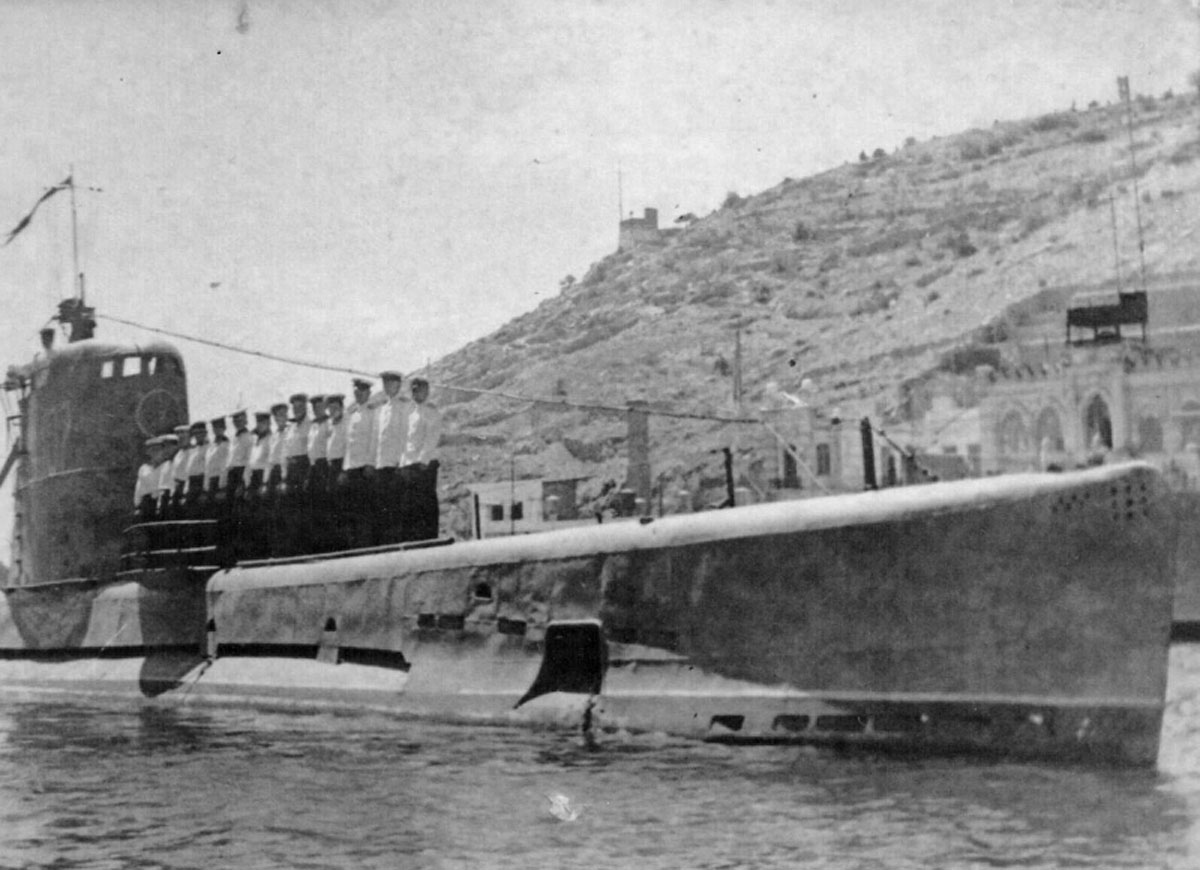







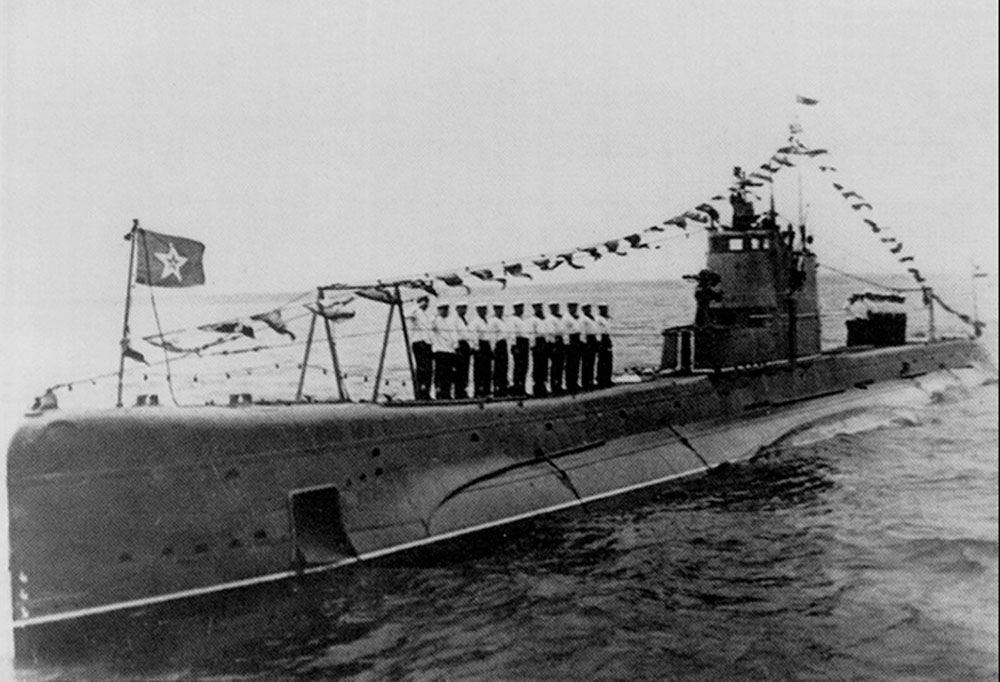



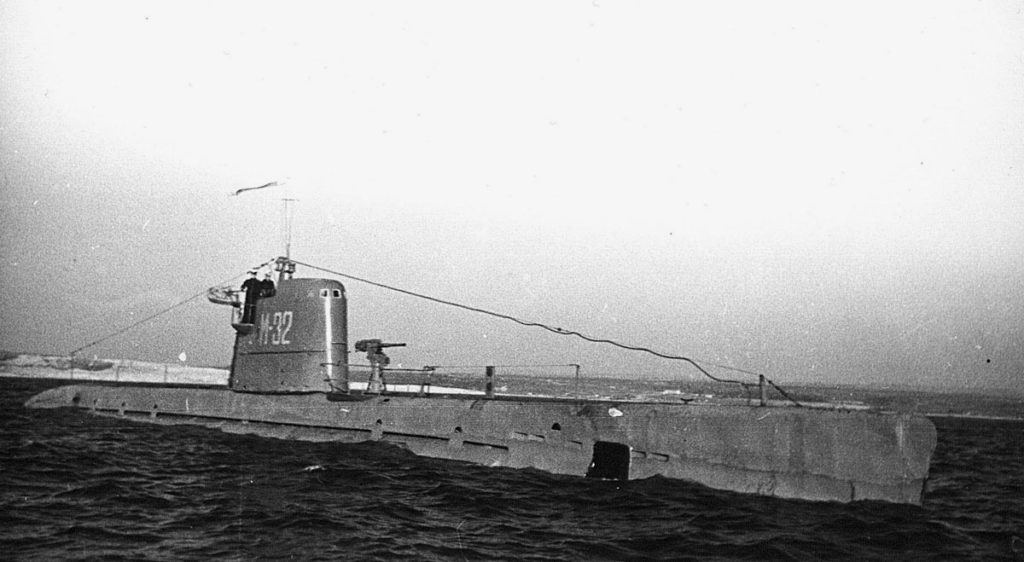
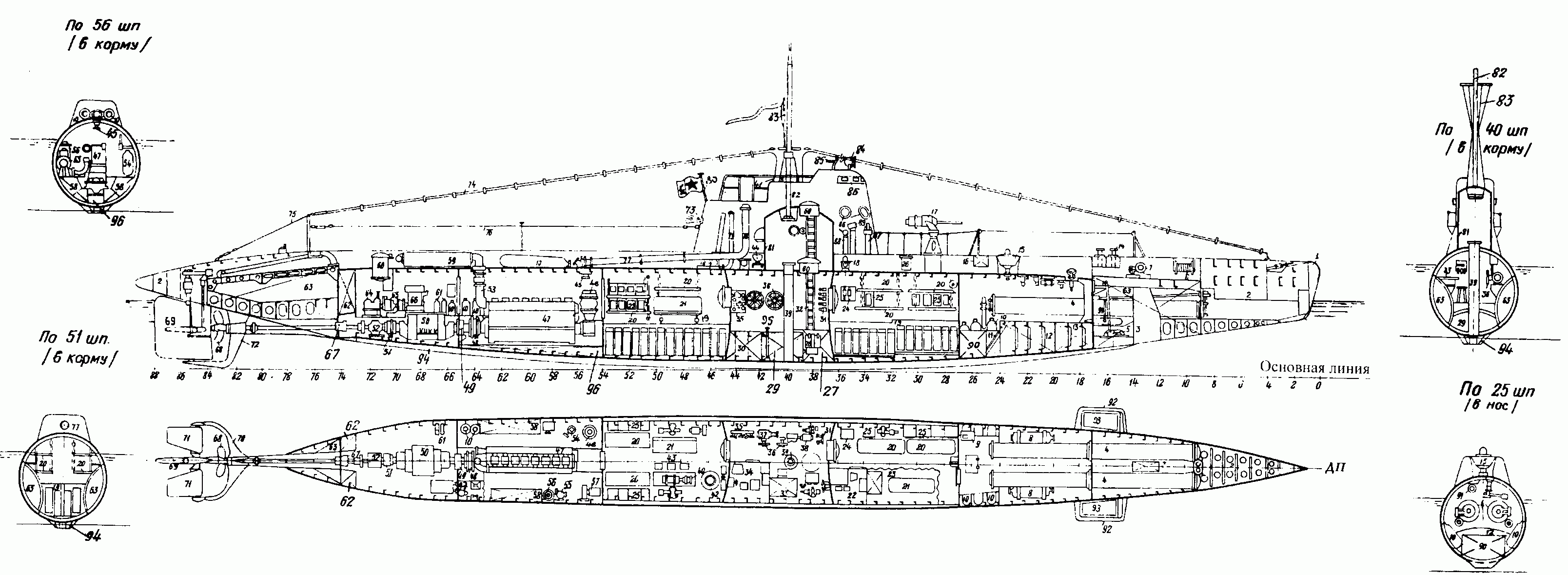
 Latest Facebook Entry -
Latest Facebook Entry -  Pinterest Board
Pinterest Board




 Austrian Navy
Austrian Navy French Navy
French Navy Royal Navy
Royal Navy Armada Espanola
Armada Espanola K.u.K. Kriegsmarine
K.u.K. Kriegsmarine Dansk Marine
Dansk Marine Nautiko Hellenon
Nautiko Hellenon Koninklije Marine 1870
Koninklije Marine 1870 Marinha do Brasil
Marinha do Brasil Osmanlı Donanması
Osmanlı Donanması Marina Do Peru
Marina Do Peru Marinha do Portugal
Marinha do Portugal Regia Marina 1870
Regia Marina 1870 Nihhon Kaigun 1870
Nihhon Kaigun 1870 Preußische Marine 1870
Preußische Marine 1870 Russkiy Flot 1870
Russkiy Flot 1870 Svenska marinen
Svenska marinen Søværnet
Søværnet Union Navy
Union Navy Confederate Navy
Confederate Navy Armada de Argentina
Armada de Argentina Imperial Chinese Navy
Imperial Chinese Navy Marinha do Portugal
Marinha do Portugal Mexico
Mexico Kaiserliche Marine
Kaiserliche Marine 1898 US Navy
1898 US Navy Russkiy Flot
Russkiy Flot French Naval Aviation
French Naval Aviation Russian Naval Aviation
Russian Naval Aviation Sovietskiy Flot
Sovietskiy Flot Royal Canadian Navy
Royal Canadian Navy Royal Australian Navy
Royal Australian Navy RNZN Fleet
RNZN Fleet Chinese Navy 1937
Chinese Navy 1937 Kriegsmarine
Kriegsmarine Chilean Navy
Chilean Navy Danish Navy
Danish Navy Finnish Navy
Finnish Navy Hellenic Navy
Hellenic Navy Polish Navy
Polish Navy Romanian Navy
Romanian Navy Turkish Navy
Turkish Navy Royal Yugoslav Navy
Royal Yugoslav Navy Royal Thai Navy
Royal Thai Navy Minor Navies
Minor Navies Albania
Albania Austria
Austria Belgium
Belgium Columbia
Columbia Costa Rica
Costa Rica Cuba
Cuba Czechoslovakia
Czechoslovakia Dominican Republic
Dominican Republic Haiti
Haiti Hungary
Hungary Honduras
Honduras Estonia
Estonia Iceland
Iceland Eire
Eire Equador
Equador Iran
Iran Iraq
Iraq Latvia
Latvia Liberia
Liberia Lithuania
Lithuania Mandchukuo
Mandchukuo Morocco
Morocco Nicaragua
Nicaragua Persia
Persia San Salvador
San Salvador Sarawak
Sarawak Uruguay
Uruguay Venezuela
Venezuela Zanzibar
Zanzibar Warsaw Pact Navies
Warsaw Pact Navies Bulgaria
Bulgaria Hungary
Hungary

 Bundesmarine
Bundesmarine Dutch Navy
Dutch Navy Hellenic Navy
Hellenic Navy Marina Militare
Marina Militare Taiwanese Navy
Taiwanese Navy Chinese Navy
Chinese Navy Indian Navy
Indian Navy Indonesian Navy
Indonesian Navy JMSDF
JMSDF North Korean Navy
North Korean Navy Philippines Navy
Philippines Navy ROKN
ROKN IDF Navy
IDF Navy Royal New Zealand Navy
Royal New Zealand Navy Egyptian Navy
Egyptian Navy South African Navy
South African Navy

































 RN
RN
 Marine Nationale
Marine Nationale
 Soviet Navy
Soviet Navy
 dbodesign
dbodesign